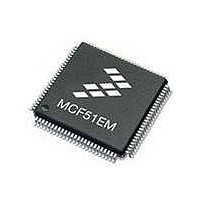MCF51EM256CLL Freescale Semiconductor, MCF51EM256CLL Datasheet - Page 377

MCF51EM256CLL
Manufacturer Part Number
MCF51EM256CLL
Description
IC MCU 32BIT 256KB FLASH 100LQFP
Manufacturer
Freescale Semiconductor
Series
MCF51EMr
Datasheets
1.MCF51EM128CLL.pdf
(2 pages)
2.MCF51EM128CLL.pdf
(54 pages)
3.MCF51EM128CLL.pdf
(636 pages)
Specifications of MCF51EM256CLL
Core Processor
Coldfire V1
Core Size
32-Bit
Speed
50MHz
Connectivity
I²C, SCI, SPI
Peripherals
LCD, LVD, PWM, WDT
Number Of I /o
63
Program Memory Size
256KB (256K x 8)
Program Memory Type
FLASH
Ram Size
16K x 8
Voltage - Supply (vcc/vdd)
1.8 V ~ 3.6 V
Data Converters
A/D 16x12b
Oscillator Type
External
Operating Temperature
-40°C ~ 85°C
Package / Case
100-LQFP
Processor Series
MCF51EM
Core
ColdFire V1
Data Bus Width
32 bit
Data Ram Size
16 KB
Interface Type
RS-232, LIN
Maximum Clock Frequency
50 MHz
Number Of Timers
3
Operating Supply Voltage
1.8 V to 3.6 V
Maximum Operating Temperature
+ 85 C
Mounting Style
SMD/SMT
3rd Party Development Tools
JLINK-CF-BDM26, EWCF
Development Tools By Supplier
DEMOEM
Minimum Operating Temperature
- 40 C
Lead Free Status / RoHS Status
Lead free / RoHS Compliant
Eeprom Size
-
Lead Free Status / Rohs Status
Lead free / RoHS Compliant
Available stocks
Company
Part Number
Manufacturer
Quantity
Price
Company:
Part Number:
MCF51EM256CLL
Manufacturer:
FREESCALE
Quantity:
110
Company:
Part Number:
MCF51EM256CLL
Manufacturer:
Freescale Semiconductor
Quantity:
10 000
- Current page: 377 of 636
- Download datasheet (11Mb)
The bus rate clock is the main system bus clock for the MCU. This clock source requires no
synchronization because it is the clock that is used for all internal MCU activities including operation of
the CPU and buses.
In MCUs that have no PLL or the PLL is not engaged, the fixed system clock source is the same as the
bus-rate-clock source, and it does not go through a synchronizer. When a PLL is present and engaged, a
synchronizer is required between the crystal divided-by two clock source and the timer counter so counter
transitions will be properly aligned to bus-clock transitions. A synchronizer will be used at chip level to
synchronize the crystal-related source clock to the bus clock.
The external clock source may be connected to any TPM channel pin. This clock source always has to pass
through a synchronizer to assure that counter transitions are properly aligned to bus clock transitions. The
bus-rate clock drives the synchronizer; therefore, to meet Nyquist criteria even with jitter, the frequency
of the external clock source must not be faster than the bus rate divided-by four. With ideal clocks the
external clock can be as fast as bus clock divided by four.
When the external clock source shares the TPM channel pin, this pin should not be used for other channel
timing functions. For example, it would be ambiguous to configure channel 0 for input capture when the
TPM channel 0 pin was also being used as the timer external clock source. (It is the user’s responsibility
to avoid such settings.) The TPM channel could still be used in output compare mode for software timing
functions (pin controls set not to affect the TPM channel pin).
16.4.1.2
An interrupt flag and enable are associated with the 16-bit main counter. The flag (TOF) is a
software-accessible indication that the timer counter has overflowed. The enable signal selects between
software polling (TOIE=0) where no hardware interrupt is generated, or interrupt-driven operation
(TOIE=1) where a static hardware interrupt is generated whenever the TOF flag is equal to one.
The conditions causing TOF to become set depend on whether the TPM is configured for center-aligned
PWM (CPWMS=1). In the simplest mode, there is no modulus limit and the TPM is not in CPWMS=1
mode. In this case, the 16-bit timer counter counts from 0x0000 through 0xFFFF and overflows to 0x0000
on the next counting clock. TOF becomes set at the transition from 0xFFFF to 0x0000. When a modulus
limit is set, TOF becomes set at the transition from the value set in the modulus register to 0x0000. When
the TPM is in center-aligned PWM mode (CPWMS=1), the TOF flag gets set as the counter changes
direction at the end of the count value set in the modulus register (that is, at the transition from the value
set in the modulus register to the next lower count value). This corresponds to the end of a PWM period
(the 0x0000 count value corresponds to the center of a period).
Freescale Semiconductor
Counter Overflow and Modulo Reset
MCF51EM256 Series ColdFire Integrated Microcontroller Reference Manual, Rev. 8
CLKS
00
01
10
11
Table 16-7. TPM Clock Source Selection
No clock selected (TPM counter disabled)
TPM Clock Source to Prescaler Input
Fixed system clock
External source
Bus rate clock
Timer/PWM Module(TPM)
16-15
Related parts for MCF51EM256CLL
Image
Part Number
Description
Manufacturer
Datasheet
Request
R

Part Number:
Description:
BOARD DEMO HARDWARE ONLY
Manufacturer:
Freescale Semiconductor
Datasheet:

Part Number:
Description:
IC MCU 32BIT 128KB FLASH 100LQFP
Manufacturer:
Freescale Semiconductor
Datasheet:

Part Number:
Description:
IC MCU 32BIT 128KB FLASH 80LQFP
Manufacturer:
Freescale Semiconductor
Datasheet:

Part Number:
Description:
IC MCU 32BIT 256KB FLASH 80LQFP
Manufacturer:
Freescale Semiconductor
Datasheet:
Part Number:
Description:
Manufacturer:
Freescale Semiconductor, Inc
Datasheet:
Part Number:
Description:
Manufacturer:
Freescale Semiconductor, Inc
Datasheet:
Part Number:
Description:
Manufacturer:
Freescale Semiconductor, Inc
Datasheet:
Part Number:
Description:
Manufacturer:
Freescale Semiconductor, Inc
Datasheet:
Part Number:
Description:
Manufacturer:
Freescale Semiconductor, Inc
Datasheet:
Part Number:
Description:
Manufacturer:
Freescale Semiconductor, Inc
Datasheet:
Part Number:
Description:
Manufacturer:
Freescale Semiconductor, Inc
Datasheet:
Part Number:
Description:
Manufacturer:
Freescale Semiconductor, Inc
Datasheet:
Part Number:
Description:
Manufacturer:
Freescale Semiconductor, Inc
Datasheet:
Part Number:
Description:
Manufacturer:
Freescale Semiconductor, Inc
Datasheet:











